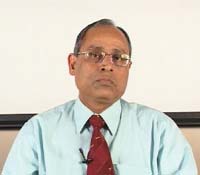AeroIndia 2009: DRDO has developed extreme technologies, says Dr Prahalad
09 Feb 2009
Dr Prahalad,
Distinguished scientist and chief controller, R&D (SI), DRDO
1. Could you speak about the Akash and Nag missiles? How do they fare with comparable technologies and how far away are they from induction?
 |
| View video: Dr Prahalad |
So, it was given the maximum time also, as compared to Prithvi, Trishul and Agni and others. Akash and Nag were given nearly 15 years. So, we knew at that time it was a very complex system and taking up the challenge we began developing these two systems.
In case of Akash, it has been uniquely configured and customised for our own Indian Army and air force. During the initial discussions with the army and the air force, they gave some requirements like it should be mobile, it should have a 30 km range, a very effective high kill probability, it should be integrated with the automatic command and control system, it cannot be manually operated, should have multiple target handling capability, which means that several targets could be engaged with several missiles simultaneously.
In most missile systems you have boost and coast – that is you boost the missile for some time and allow it to coast, or, boost, sustain and coast. The requirement here, however, was continuous thrust, or, all the way thrust. Once you start coasting, the maneuverability of the missile comes down. This was not acceptable to the services. They felt it should be continuously maneuverable till it intercepts the target, which meant the requirement was that the power/thrust had to be continuously on.
These were a unique set of requirements –such a missile doesn't exist anywhere in the world and it meant that we had to uniquely configure the missiles. That's how Akash was realised, We took 5 years more than what we promised to the army and air force, but when tested in the last development phase the results were 9/9 –that is out of the 9 missiles tested all them met the guidance and accuracy control requirements. Based on these tests the Indian Air Force has placed orders for 2 squadrons and the army is expected to follow suit.
Bharat Electronics will be the nodal production agency along with Bharat Dynamics and there will be at least 40 industries from the public and private sectors that will be involved with the manufacture of these missiles in large numbers.
So, this is one story and we expect that based on the expenditure of Rs600 crore that we have invested in the Akash missile, business worth about Rs7,000 crore should result for radars, missiles, launchers and control systems all put together within the next 5 years.
So, this is the story for Akash.
Coming to Nag, similarly, this missile is meant for the army, which wanted a missile with a 4-km range and fire-and-forget capability. That means we launch the missile from a tank and leave the place - this is also called the shoot-and-scoot technique. The Nag was specifically designed with a fire-and-forget capability.
The missile has what is called a tandem warhead. The warhead will have two stages – in the first stage the missile will make a hole in an enemy tank and in the second stage it will go inside and blow it up. This is a very special technology and we had to perfect it.
So this is the Nag- a tandem warhead, 4-km, tank-mounted, fire-and-forget, and very accurate, missile.
The last flight test has been successfully completed in day and night desert conditions in short range and long range test firings and we expect the army to place an order over the next couple of months.
2. The 'Shaurya' was a surprise development – where does it fit into the Indian missile spectrum?
If you look at our long-range strategic missiles you know we have Prithvi and Agni for ballistic or near-ballistic systems. Prithvi is a liquid fuel system and Agni is a solid fuel system.
Now the Agni has certain mobility, certain freedom to move from place to place. The Prithvi has its own certain requirements - it requires preparation time because of its liquid engines.
So we had to configure a unique third missile called 'Shaurya' which can be canisterised. Once sealed in a canister, it can be taken to any place giving it great tactical and operational advantage. It canbe deployed anywhere - in hilly terrain, desert etc. It is a relatively light, highly mobile, solid propellant fuelled missile. There is no preparation required.
So it has its own USP - and as per the requirement of the services we will be taking up the production of Shaurya.
3. The country's BMD technology would appear to be moving apace – could you dwell on aspects of the technologies that are being brought into play for the whole programme?
Ballistic Missile Defence or missile defence systems, are developed based on the threat perceptions as presented to us by the armed forces, which take into consideration threats from our neighbours, their plans etc. Based on these inputs we are developing certain critical technologies against ballistic missiles.
For this we need some unique technologies, such as high-speed propulsion, which can take missiles to hypersonic speeds. You need a high burning rate, solid propellants, which can take the missile quickly to high Mach number.
We need very high accuracy guidance so that the missile can even physically obliterate a hostile missile – what is called a hit-to-kill capability. For this we need not only radio gadgets but also thermal infra-red gadgets. So for this we need a combined dual-guidance –not only radar but also imaging guidance. This requires very high accuracy algorithms.
Also we need very quick reaction systems. When somebody launches a ballistic missile the time available to react to the threat is very short - a few seconds. So, the instant you know a missile has been launched you have to launch the defence system within seconds, fly at a much higher speed than the attacking missile and intercept very accurately at very high altitudes. So this requires what is known as extreme technologies. These have now been developed and we are trying to integrate these technologies and produce a weapon that can be used by the armed forces.
4. How do you look at an era of increased international cooperation in the development of technologies in the defence sector?
This is the new era of 2000+. In the 80s when we started our major system programmes like Arjun or Sonar or IGMDP or torpedo or radar, we never had the opportunity of international co-operation.
We were buying some components and making everything in-house. We built the computer from scratch from circuit boards. That was an era where we had to do everything in-house and within our industries and everything was a long drawn out and hard process.
Whereas in 2000, fortunately, the whole world has recognised our capability by seeing our LCA, main battle tank Arjun, radars, torpedoes, missiles and small arms that are in production. Our capabilities in prototyping, developing, testing and fielding our own weapons have been recognised.
So now they know that they cannot take us for granted. If they want business, they have to work together. Many countries have come forward for collaborative research and joint development. We have projects now with USA, Israel, Russia, Italy, Germany, Belarus, Brazil, France, UK among others.
In the 80s era what used to take 15 years to make we can now make in 5 years to 7 years. So, we have cut down the development time by almost 1/3rd because of the immense opportunities for international collaboration.
5. With respect to the areas of missiles could you dwell on two aspects:
b)One being the development of technology in this sector
c)The level of operationalisation that such technology has attained
Missile technologies are front-end technologies - very challenging and display characteristics such as high speed, high lethality, high maneuverability and quick reaction. So all this require the limits of technology whether you take materials, propulsion or control.
So of the technologies for this kind of technology for eg propulsion: solid propulsion, liquid propulsion and ramjet propulsion or if you take flight control systems and autocontrol systems, we need computers, electro actuation systems, lot of software intelligence for making the control system work and then we have navigation and guidance, we have to take the missile to long distances and guide it accurately to intercept the target.
When we take the warheads, each missile requires a different type of warhead Nag requires a tandem warhead, Akash requires a fragmentation warhead, Prithvi requires a runway penetration warhead.
We also have the C4I - command, control communication and intelligence integration. How do we do it? The missile is the part of network centric operation. We have to also develop guidance on how to use radar gadgets and imaging infrared technology to recognise targets using its thermal characteristics by getting a thermal picture to reach the tank and finding out its centre of gravity to hit it at the centre of the tank. This type of technology is the imaging infrared technology and you need millimeter wave technology for very accurate guidance and infrared imaging for imaging of a target.
So these technologies are required to be simultaneously developed for the missiles India has developed.
For operationalisation, these technologies go into the missiles eg: the Akash missile the ram jet propulsion is inside; the pre-fragmented warhead technology inside, very accurate radio or radar guidance is used in the missile system and auto pilot with a very powerful computer to make the missile maneuver to hit a maneuvering target, so you can out-maneuver a maneuvering target, at low, medium and high altitudes under any conditions rain, dust, summer, winter night etc.
So, these technologies get imbibed into the missile system, the ground system, the launcher system, and is integrated into the command control network. So the technology gets operationalised in the missile systems when they get fielded.
Now how we get these technologies? We have three strategies to develop: some of it is got from academic institutions. We go to the university professors, work with them on how to develop new science and technology.
Secondly, DRDO can jointly develop new technologies with industrial partners. For example, an actuation system, which we have mostly done in DRDO-industry collaboration.
Then comes foreign collaboration. Sometimes we develop technologies with foreign collaboration with our partner countries.
If none of this works, then the final strategy is in-house development within our laboratories and we have developed many technologies in-house.
So this is how we develop new technology, new science, perfect it and incorporate it into weapon systems
6. Obviously there exists 'dynamic tension' between the need to develop indigenous technologies and the need for the services to be in a state of readiness, armed with contemporary technologies. How do you harmonise such tensions?
Fortunately this harmonisation is already taking place. Probably there was some gap in the capabilities of DRDO and the requirements of the armed forces. They require it fast and the latest to be made available. Since things were always available to them on their tables they always were bombarded with temptations to purchase but today two things are happening - arms research development and marketing has slowed down tremendously worldwide in comparison to the '80s. They are no more developing things just like that but develop it only on demand.
Secondly the armed forces have realised that a homegrown weapon system, sonar or radar etc has many advantages to them. They will be able to get life support very easily, product up-gradation, software and customisation. So, many things are possible and finally both cost of ownership, maintenance will be much lower if it is indigenously based and the things are available at your fingertips. So the armed forces are also trying to tap DRDO's capabilities to the maximum.
The gap between the user's needs and DRDO's capabilities is reducing. Today we are able to sit down with the army, navy air force to work out a road map on the kind of weapons they would need in the next 5-7 years. What new technologies they think we should develop and how to realise these technologies?
Thus we have generated 2 road maps - one for technology and the other for products. We have had extensive discussions on these even up to how they should look. For example Rustum, a medium altitude, long endurance unmanned vehicle where we have combined QRs (qualitative requirements) where the order rate is above 100 for all forces combined. When the services say that if you can develop this within the next 4 years within our requirements, at least an order of x number will be placed. The services are ready today how much they will order called MOQ (minimum order quantity).
When we have such a guarantee from the buyers, then it is easy to go the industry which can work with us to expedite the development because the industry will make the prototype, assemble it immediately and production time or realisation time will come down. Some of the industry partners are ready to fund the development cost also, even if it is 15 per cent or 20 per cent. When they fund the development cost they become the stakeholders and then responsibility increases and then it is produced according to specifications within the stipulated time and assemble and market it as well.
So, we are tying up the industry, the MOD, the three services and DRDO – we are converging, synergising, harmonising so we work together and see that the systems are developed for the good of the country, to meet our own a la carte service - customised to the taste, schedule, performance, quality, upgradation.
Plus this is also good for the health of the Indian economy as employment opportunities increase and industry capabilities increase, even drawing orders from other countries. Based on these technologies, I have observed that many of our SME and small-scale industries getting export orders.
So you see how the level of the economy goes up, the employment potential increases, our knowledge expands, university research level goes up, and our own departments of science and technology, their own understanding and knowledge goes up. So, as a country we can see an elevation of status technologically and economically.
With this harmony we see many good things happening.









.webp)














